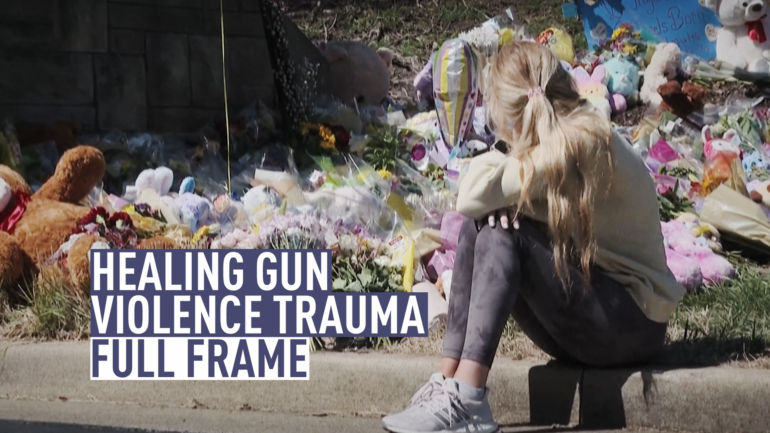Daily headlines about shootings flood the news in the United States. As the shootings continue, how do those touched by gun violence move forward?
‘Trauma is a beast’
1 in 5 American adults have had a family member killed by a gun, according to a survey by the Kaiser Family Foundation. Among people of color, gun violence plays an even bigger role, with 1 in 3 black adults saying they have personally witnessed a shooting.
“We cannot talk about gun violence without talking about systemic racism,” said Ryane Nickens, founder of the nonprofit The TraRon Center.
Nickens lost her brother, sister and uncle to gun violence. The TraRon Center is a refuge for gun violence victims. The nonprofit offers counseling programs, therapeutic arts, and workshops to raise community consciousness about the impact of gun violence.
“Trauma is a beast,” Nickens said. “It is that thing where you want to get through as quickly as possible, but it’s a process. And that thing that happened to you will always be with you, but it’s the response, to it create healthy responses. That’s what helped me.”
A movement against gun violence
In 2019, the Parkland school shooting became one of the deadliest mass shootings in U.S. history. A 19-year-old former student shot and killed 17 people at the Marjory Stoneman Douglas High School. Seventeen more were injured.
What happened next changed the course of the guns debate, growing into a national movement.
As the teenage survivors reacted and took to the media, the attention grew and ballooned into a call for change. The teens demanded immediate government action and assailed adults for failing to protect them. Author Dave Cullen interviewed the leaders in the weeks after the shooting, culminating in his book, Parkland: Birth of a Movement. He previously wrote a book about the Columbine shooting.
His book captures the emotional journey some of the students went on in the days and weeks after the shooting.
“One of the most heartbreaking ones is this kid says, All these things are coming up, especially prom and graduation, and we want to have fun and enjoy them, and are we allowed? Is that okay? And then he was crying,” Cullen said.
He also captures the resilience of these students in navigating their new lives.
“You’re going to get a life back,” he said. “The one you had is gone. It’s never coming back. And the first step in your recovery is accepting that and grasping that you can have a fine life.”
Recognizing the signs
More than a decade ago, a gunman shot and killed 20 first-grades and six educators at Sandy Hook Elementary School in Newtown, Connecticut. On December 14, 2012, Mark Barden sent off his three children, James, Natalie, and seven-year old Daniel to school.
“Our governor at the time collected the remaining families in a room in the firehouse,” Barden said. “And that’s when they announced that six educators and 21st grade children had been shot to death and that if you haven’t been connected with your loved one, they’re probably laying dead in the school.”
Barden and some of the parents of victims created the Sandy Hook Promise, a commitment to try to stop these school shootings.
“We now know 100% of school shooters talk about it or give off warning signs before they commit the act,” said Barden, CEO of Sandy Hook Promise. “ That means that anyone who’s connected to that person has an opportunity to interpret and identify those warning signs and then take action to get them to help before it becomes a tragedy.”
Some 18 million Americans have gone through the program. And 115,000 tips have been anonymously reported.
Barden says policies alone will not completely eliminate gun violence, but they can help.
“So closing the background check loophole for all ages at the federal levels … are proven effective,” he said. “I believe that weapons that were designed for battlefield use with a singular purpose of killing as many people as possible in a short amount of time, do not belong in the hands of untrained civilians.”
 CGTN America
CGTN America
